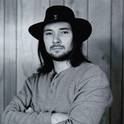
Spectral features of a large-angle stimulated Raman scattering (LA SRS) of a short electromagnetic pulse in an underdense plasma, which are caused by the presence in a plasma of a given linear long-wavelength electron plasma wave (LW EPW), are investigated. It is shown that the LW EPW, whose phase velocity coincides with a group velocity of a pulse and a density perturbation normalized to a background electron density, \delta n_{LW} / n_0, exceeds the ratio of the electron plasma frequency to the laser frequency, \omega_{pe} / \omega_0, suppresses the well-known Stokes branch of the weakly coupled LA SRS. Under the same condition, the anti-Stokes band appears in the spectrum of the scattered radiation. Variation of a scattering angle and an electron temperature do not significantly modify qualitative features of the effect. In the case of strongly coupled LA SRS, the maximum of the increment is decreased by nearly one-half for \delta n_{LW} / n_0 ~ (a_0 \omega_{pe} / \omega_0)^{2/3} >> \omega_{pe} / \omega_0, where a_0 is an amplitude of an electron quiver velocity in the laser field normalized to a speed of light , and it decreases further with an increase in plasma density perturbation in LW EPW.
- Stimulated Raman scattering in plasmas,
- parametric processes in laser plasmas,
- Langmuir mode coupling,
- convective instability
Available at: http://works.bepress.com/serguei_kalmykov/35/
